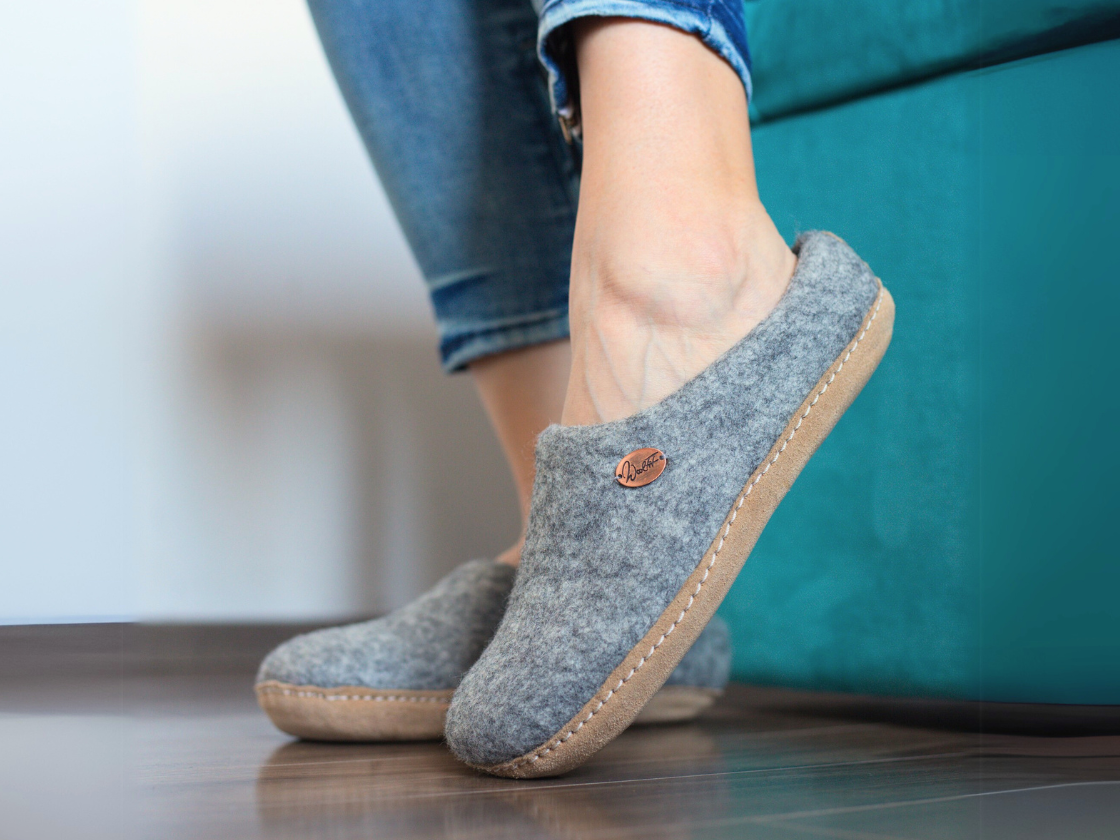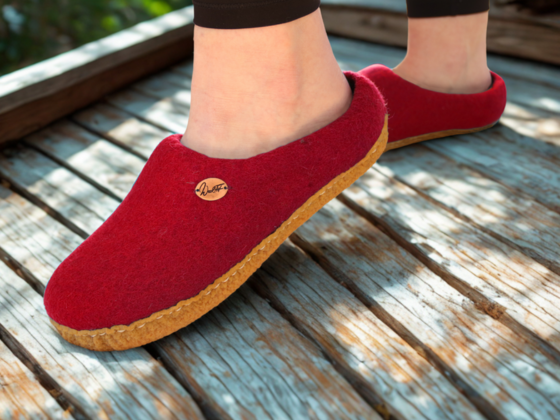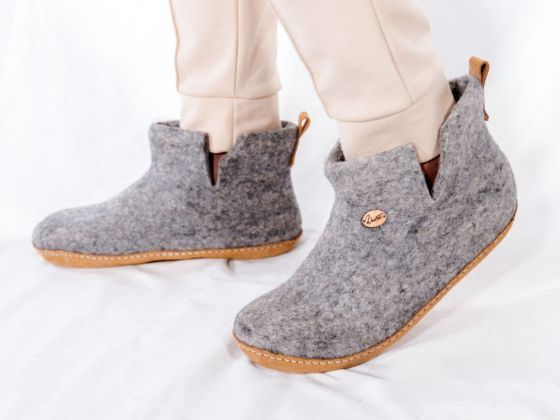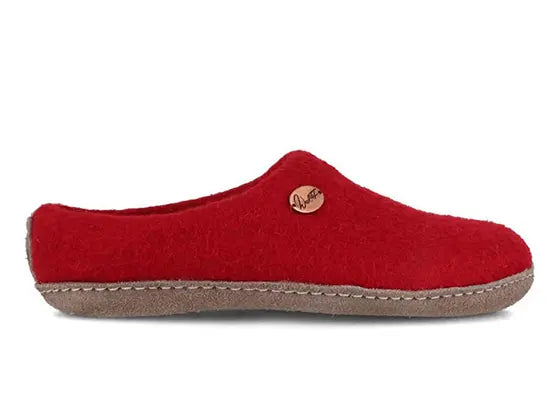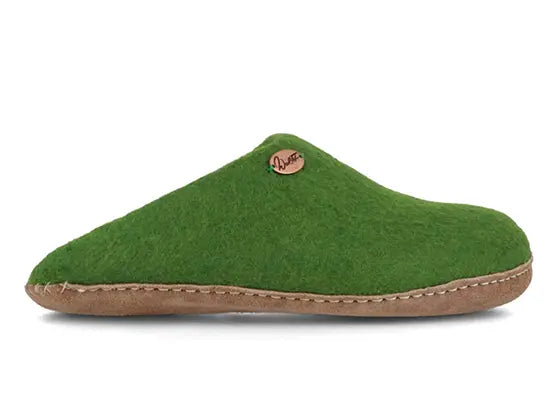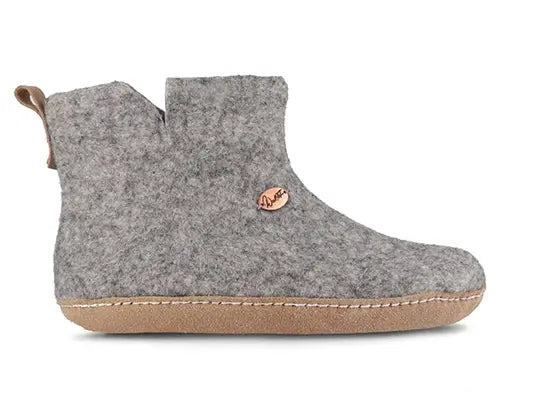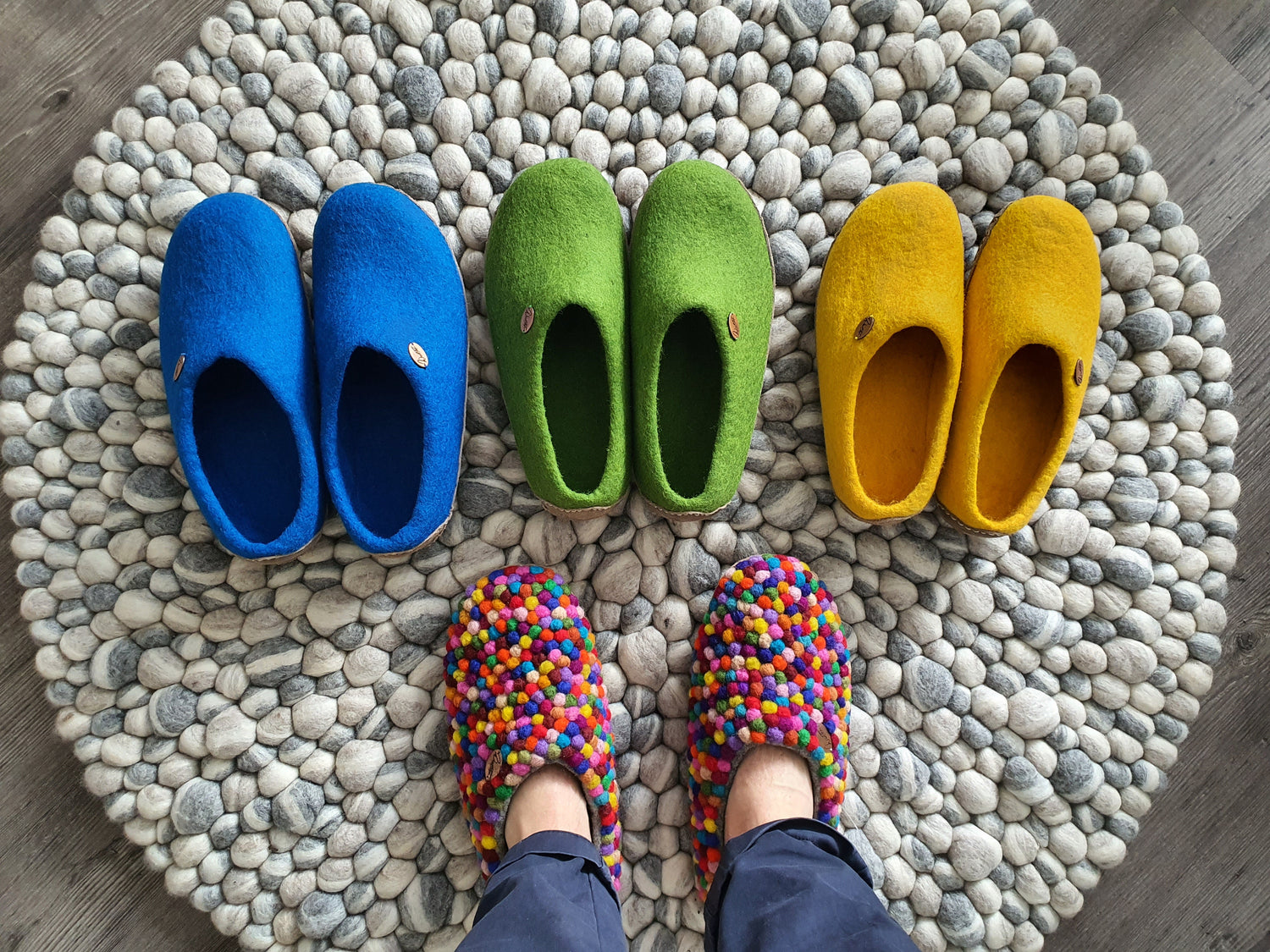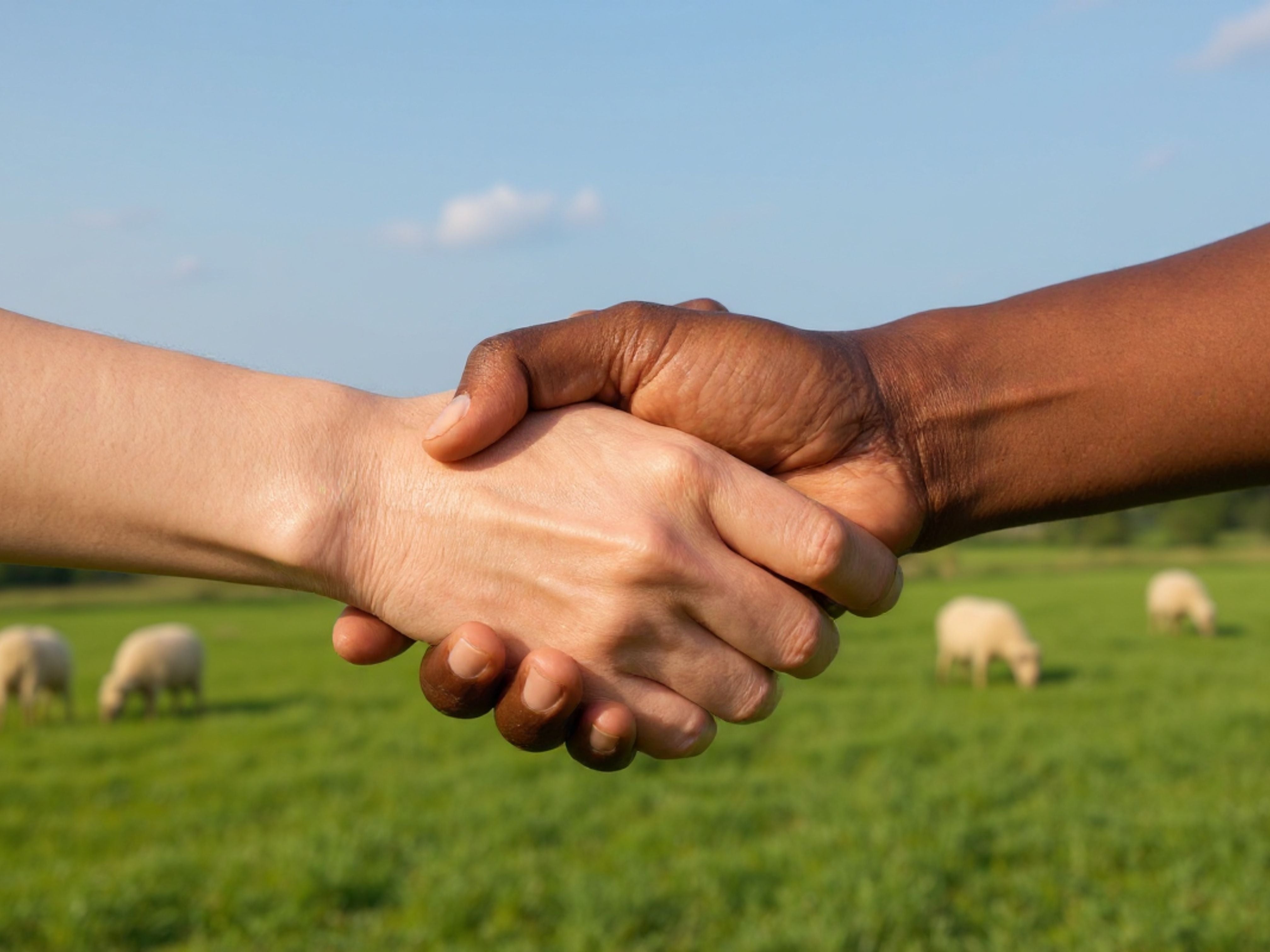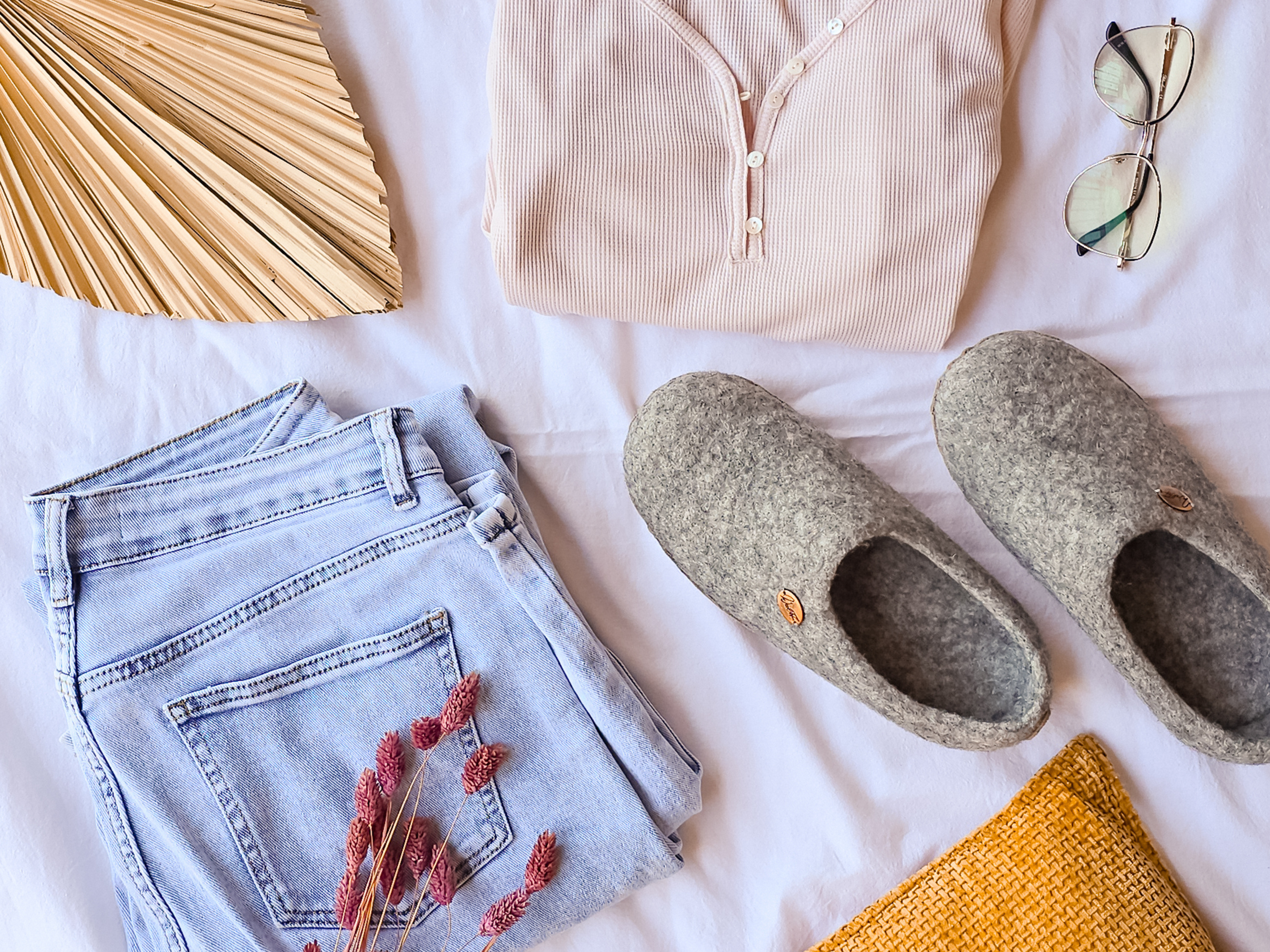We all probably know someone who wears barefoot shoes, and maybe this person has tried to get you excited about barefoot shoes.
There is currently a real hype about shoes with thin soles, also known as minimal shoes.
In this blog post you will learn in 5 minutes:
-
what makes a barefoot shoe
-
what advantages and possible problems there are
-
and which WoolFit barefoot slippers are the right choice for you
1. What makes a barefoot shoe?
Foot-friendly shape and wide toe box:
With conventional shoes, the toes are often forced into an unnatural shape due to the "fashionably" slim shape. Barefoot (slip) shoes can restore the natural toe spread of the feet over time.
If you are looking for a barefoot slipper with a particularly spacious toe box, we recommend our WoolFit Footprint barefoot slipper, which has the widest toe box of all our models.
-
Flexible material:
In order to allow the foot to roll naturally, it is important that both the sole and the upper material of the shoe bend slightly.
The following applies here: the more flexible, the easier it is mentally to perform a natural walking movement.
With felt barefoot shoes, it is important that the felt is not too hard. All models from WoolFit are suitable for this.
-
Very thin sole:
The thinner the sole, the more you feel the surroundings. Our feet are actually just as sensitive as our hands. With a particularly thin sole, our feet learn to feel properly again.
Our Footprint barefoot slippers, on the other hand, have a thick layer of felt, so you don't feel everything, but you feel damn comfortable! Like walking barefoot - just soft and warm.
If you want to train your foot sensors, we recommend our WoolFit FeelGood footbed, which simulates walking on uneven ground with the small felt balls. We also have feedback from customers with neuralgic problems in their feet (nerve damage) who have experienced a significant improvement with the footbed.
-
Zero heel:
Ordinary shoes have a raised heel area, which is intended to provide special step cushioning. This disturbs the balance of the body. Because this tries to compensate for the increased angle by leaning back slightly, which affects your posture and your gait.
For everyone who wants a zero heel, we recommend the WoolFit Footprint or the WoolFit Tibet.
-
Minimal longitudinal arch support:
Walking barefoot is designed to strengthen the foot muscles, so the foot is inherently healthier and doesn't need additional support.
Our WoolFits rely on a slightly supportive felt footbed. This gives you a footbed feeling without "doing the work for you" because it is so soft and flexible that the foot is still sufficiently challenged.
2. What are the advantages of barefoot shoes or slippers?
-
Strengthening or regeneration of the foot muscles & prevention of malpositions:
In many people, whose feet have been placed in an unnatural position for decades due to tight, sturdy shoes, the foot muscles have literally atrophied. When walking barefoot, on the other hand, the foot muscles are properly challenged again and used to cushion your body weight, which, after millions of years of evolutionary development, they are actually perfectly geared to. This natural use of the foot muscles, intended by nature, actively prevents malpositioning of the feet, which, on the other hand, is encouraged by shoes that are too tight.
-
Stabilization of the ankle joints and strengthening of tendons and ligaments:
The tendon system in the soles of your feet is also specifically stressed when walking barefoot. Along with the strengthening of the muscles, the many tendons and ligaments that hold your foot together are also strengthened. In addition, the ankles are stabilized, which makes you less prone to spraining, even on adverse & uneven floors, because the entire musculoskeletal system of your feet is strengthened. As a result, after a while you will find that you are simply more light-footed and agile and really enjoy running and walking.
-
Promotion of the sense of balance, fine motor skills & the entire body balance:
When walking barefoot, the nerves on the soles of your feet are in active communication with your brain, since you have to react immediately to bumps or sharp objects by avoiding or adjusting your posture. Therefore, regular barefoot walking and the conscious perception of different floors will also sharpen your sense of balance, your reflexes and fine motor skills.
-
The blood circulation in your feet is promoted:
Since the foot muscles are properly stressed when walking barefoot, the blood circulation in the feet is also automatically promoted. The stimulated blood circulation creates natural body heat. This prevents you from getting cold feet when walking on cold stone floors or tiles, despite the very thin soles typical of barefoot shoes. With our Footprint barefoot slippers, you also have a nice, thick felt sole that insulates perfectly - so you are guaranteed not to get cold feet, even if you don't move.
-
The perception of different floors through the highly sensitive soles of the feet is a real sensory experience & reduces stress:
Perhaps you can still remember the feeling of exploring the landscape barefoot as a child on different surfaces such as soft moss or sand. Even gravel soils, which many people certainly initially find categorically adverse per se, can be very pleasant and exciting to walk on with healthy feet without artificially reduced calluses (or in barefoot shoes). Because human feet are basically just as sensitive and sensory as our hands are, and just not made to be "locked up" in shoes all day, where they have to rest permanently on the same footbed. Walking on different floors can even have a downright therapeutic effect and help to relax and reduce stress after a hard day. You can try it out for yourself by simply walking barefoot on the lawn in your home garden for 5 minutes in the morning after you get up or in the evening before you go to bed.
-
Promotion of a holistically healthy posture & relief of joint, knee, back & neck pain:
Healthy feet that are used for natural walking are the basis for correct posture and thus also the cornerstone of holistic physical well-being. An unnatural foot position makes the entire body more susceptible to joint problems, back pain, neck tension and even headaches and jaw problems. The zero heel, which is typical for barefoot shoes, puts your feet in a natural position. This makes it easier to straighten the spine correctly when walking and also to bring the pelvis into a natural position, which allows the back to recover.
3. Is barefoot walking suitable for everyone? What possible problems can there be?
-
Worsening improvement in existing foot problems:
Unfortunately, many feet have already reached a point where the use of an orthopedic insole can make more sense. Because with existing malpositions, walking barefoot can lead to them becoming even more pronounced due to overloading of the foot muscles. You should therefore clarify in advance with your podiatrist or physiotherapist whether barefoot walking is also suitable for you.
-
Initial muscle soreness:
Since the foot muscles, which in most cases have already clearly receded, are properly challenged when walking barefoot for the first time in a long time, it is not uncommon for sore muscles to occur in the feet at the beginning. However, this is a positive signal that the foot muscles are being properly challenged as desired and can regenerate and rebuild as a result.
-
Initially increased perspiration:
In connection with the previous point, it can also happen that the feet tend to start sweating due to the increased exertion and blood circulation during the adjustment period, especially when the outside temperatures are warm. Experience has shown that this phenomenon subsides after a short period of acclimatization. In addition, sweating is basically nothing bad, but a vital bodily function. It usually only becomes a problem if the sweat cannot escape due to synthetic upper materials and collects in the shoes or slippers. Since the high level of breathability is a fundamental advantage of our felt slippers, these are perfect for getting started with barefoot walking, as the upper material actively counteracts increased perspiration. Excess moisture and heat are quickly absorbed by the felt and then released into the air.
4. Which barefoot slippers are right for me?
For beginners who just want a light, comfortable barefoot feeling, our WoolFit barefoot slipper Footprint has a thick, firmly integrated felt footbed, but it is so soft and flexible (just like the outer leather sole) that the foot muscles still have to work actively when walking, creating a barefoot feeling. The model also features a zero heel and a fairly wide toe box. Due to the particularly soft and flexible felt, the footprint hardly restricts the feet when walking and also gives in pleasantly if necessary.
Thank you for reading! If you have any questions, just send us an email or via social media.
Always stay nice and cozy!


